Pompeii Paul W. S. Anderson
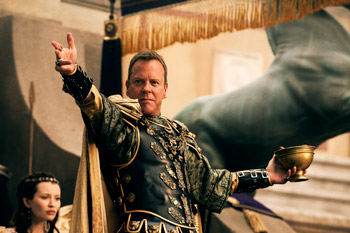
Pompeii Paul W. S. Anderson
Cast: Kit Harington, Emily Browning, Kiefer Sutherland
Director: Paul W.S. Anderson
Genre: Action, Adventure, Drama
Rated: M
Running Time: 98 minutes
Synopsis: Romance, adventure and a natural disaster of cataclysmic proportions collide headlong in Pompeii, director Paul W. S. Anderson's epic recreation of one of the ancient world's most compelling tragedies.
Set in 79 A.D., Pompeii tells the heroic story of Milo (Kit Harington), a slave turned invincible gladiator who finds himself in a race against time to save his true love, Cassia (Emily Browning), the beautiful daughter of a wealthy merchant who has been unwillingly betrothed to a corrupt Roman Senator. As Mount Vesuvius erupts in a torrent of blazing lava, Milo must fight his way out of the arena in order to save his beloved as the once magnificent Pompeii crumbles around him.
Pompeii
Release Date: February 20th, 2014
About The Production
In 79 A.D., the city of Pompeii, a glittering pleasure dome on Italy's Bay of Naples, was buried by a cataclysmic eruption of the Mount Vesuvius volcano. In just 24 hours, the bustling international port and its residents were obliterated in one of the ancient world's worst natural disasters. Hauntingly, the city and its inhabitants were preserved virtually intact by the ash and lava showered down by the volcano.
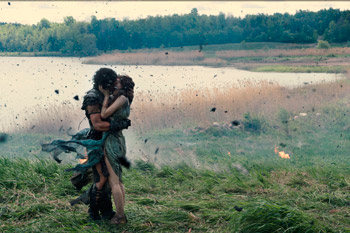 The story of a glamorous metropolis destroyed in less than a day has stayed with
The story of a glamorous metropolis destroyed in less than a day has stayed with
director Paul W.S. Anderson since he was a curious schoolboy. In his latest film, Anderson turns a lifelong obsession with Pompeii into an epic action movie, complete with gladiatorial competition, political intrigue, star-crossed lovers and a terrifying fight for survival as hell seems to rain down on earth.
grew up in the north of England, where there were a lot of archeological digs. I became quite interested in Roman civilisation and, in particular, Pompeii. The idea that a city and the people who lived in it have been frozen in time still fascinates me."
Paul W.S. Anderson and his longtime producing partner Jeremy Bolt, best known for their evocative explorations of a bleak future world in the Resident Evil series, spent over six years researching and developing Pompeii. They have created a meticulously detailed portrait of a lost world, as well as an iconic adventure that harks back to the age of the classic disaster films.
'When 3-D started to explode in the mid-2000s, Paul W.S. Anderson and I decided that the genre best served by the technology would be the disaster movie," Jeremy Bolt says. 'He suggested we put together a movie about Pompeii. We decided to make the biggest sword-and-sandal movie ever, but with a volcano."
It seemed a natural fit for Anderson, who has pushed the envelope technically
throughout his career, with pioneering work in both 3-D and CGI, all while crafting taut and tension-filled storylines. 'He combines an extraordinary visual ability with a tremendous technical knowledge and an interest in history," says Jeremy Bolt. 'And he has also an innate understanding of what the audiences will respond to. This is not a documentary, but it is firmly grounded in reality while also being exciting, exhilarating and highly emotional."
In its time, Pompeii was the most fabulous holiday resort in all of the Roman Empire, according to Paul W.S. Anderson, adding, 'It was like the Las Vegas of the Roman Empire."
'The city was filled with brothels, bars, taverns and lots of holiday activities," continues Jeremy Bolt. 'Because it was a seaport, people came from all over the Empire and it was a hive of colorful activity. Imagining who these people were and how to tell their stories was the genesis of the project."
Just after midday on August 24, Vesuvius, which had been dormant for centuries, released a gigantic cloud of volcanic ash estimated to be 19 miles high. Ash, rock and other volcanic debris poured down on Pompeii, gradually covering the city and causing the roofs of many houses to collapse under the weight. Avalanches of hot ash and gas sped through the city, instantly destroying every living thing in their paths. The city was completely buried and the vast majority of its inhabitants were killed.
Although there is a lot of archeological evidence as to what happened, says
Paul W.S. Anderson, with so few survivors, there are almost no first-hand accounts.
'Historians have relied on the accounts of Pliny the Younger, who actually witnessed the explosion from a distance," says the director. 'He wrote a series of letters detailing the disaster, but people didn't take him seriously. No one believed that a catastrophe of this magnitude was possible."
deathblow, a tsunami. The top of Mount Vesuvius blew off with such force that the volcano lost more than 2,000 feet in height. The effects have been compared to that of a nuclear blast.
But the ash that enveloped the destroyed city also preserved it for posterity. 'The images are unforgettable"loaves of bread perfectly preserved underneath the ash, a dog still on a chain"these are images of Roman life that have survived for two thousand years," says Paul W.S. Anderson.
Pompeii remained lost for almost 1,700 years, until 1748 when the Bourbon kings of
Naples started excavations, uncovering villas and public buildings. By the early 1800s, visitors to Pompeii could wander along its streets and explore its preserved buildings. Archeologists began creating plaster casts of the victims from the voids left in the ash by
their bodies, enabling visitors to the site not only to walk through the streets of the legendary city, but also to view the likenesses of the people who had inhabited it.
'When you visit now, it's an inland town a mile or more from the shore," says Paul W.S. Anderson. 'In Roman times, it was a port. The eruption filled in a mile and a half of extra shoreline.
The filmmakers made a concerted effort to keep the film as historically accurate as
possible, bringing in an expert in the era to vet the production.
Amid all that historical authenticity, Jeremy Bolt promises the audience a spectacle worthy of a Roman Amphitheatre. 'You're going to see lava bombs," he says. 'You're going to see a blizzard of ash and a river of pyroclastic flow, which is essentially boiling steam, traveling at a high speed and incinerating everything in its path. You're going to see a tidal wave. You're going to see an earthquake. And that's just the last act. Even before that we have sensational gladiatorial combat and war in Britannia, all of it seasoned with big emotions and a huge love story."
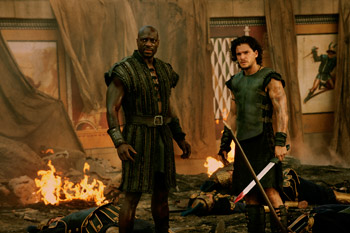 The Cast Of Pomeii
The Cast Of Pomeii
Paul W.S. Anderson and the producers of Pompeii assembled a talented and appealing group of performers who deliver stirring dramatic performances against the backdrop of the impending cataclysm. 'We have a story that's so powerful and characters that are so believable," explains Jeremy Bolt. 'We were determined to find actors that so completely engage the audience that by the time the volcano explodes, you've almost forgotten there is a disaster on the way."
Filling the film's leading role, Milo, posed multiple challenges, especially since the
But Milo is no ordinary slave. His strength and cunning in the ring have been nurtured by years of rage and determination to avenge his parents' murder. 'There's a sense of destiny in his story," Paul W.S. Anderson says. 'When he gets to Pompeii, he finds the man who killed his people. He believes that his gods are helping him take vengeance."
Kit Harington, familiar to audiences as the dark and brooding Jon Snow on the
popular series 'Game of Thrones," was selected to play the fiery Celtic gladiator. 'We wanted somebody fresh and exciting who would take the audience by surprise," says Bolt. '-Game of Thrones' is a massive TV phenomenon, but Kit Harington hasn't been the lead in a huge movie like this before. He has all the emotion and charisma"as well as the physical presence and ability"that we needed for this role."
The actor says he was immediately drawn to the role of Milo. 'I knew this would be
a terrific project to be a part of. I love action. Milo's tragic backstory and quest for vengeance appealed to me. Then I met Paul W.S. Anderson. He is so wonderfully enthusiastic and committed to what he does. He knows so much about old-school filmmaking, and he's also always willing to experiment with new technological developments."
The historical aspect of the film held great appeal to Kit Harrington as well. 'I've done
lots of period movies and I genuinely enjoy them," he says. 'Growing up in Britain, the story of Pompeii and the eruption of Vesuvius resonated with me. I was most intrigued by the plaster casts of the people caught in the eruption. I loved the idea of taking this horrific event, throwing a load of quite interesting characters into the mix, and making it into an entertaining watch."
Milo is the most physically demanding role the actor has ever taken on. 'I was on set every day and when I wasn't filming, I was in stunt rehearsal," he says. 'It was tough. Paul W.S. Anderson demands a lot from his actors, but I like that in a director."
His training began more than a month before filming started. 'Kit Harington certainly looks like a movie star, but he wasn't the gladiator that we needed at that time," says Paul W.S. Anderson. 'He became very focused on getting the perfect physique, which is what you see in the movie. He looks awesome."
The character's strength is not just physical, says the director. 'He has a strength of
character as well. Early in the film, he has to put a horse out of its misery. It's an impressive scene and the moment that he captures Cassia's heart."
The daughter of one of Pompeii's most powerful families, Cassia is returning from her studies in Rome when she meets the slave caravan bringing Milo to Pompeii. Intelligent, independent and determined, Cassia is ready to defy convention to get what she wants. To play the young noblewoman, the filmmakers selected Australian actress Emily Browning.
'Cassia is a very complicated character and the success of the movie depends on her," says Paul W.S. Anderson. 'Emily Browning is still very young, but she already has an incredible body of work behind her. When we met with her, we thought the chemistry between her and Kit Harington would be electric. That was essential because the love story is really the heart of the movie."
The entire passionate love affair between the aristocrat and the slave spans just 48
hours. 'They only meet a few times and it was very important that those meetings be really dynamic," notes Paul W.S. Anderson. 'They don't even touch; they just look at one another."
'Emily Browning did a terrific job," says Jeremy Bolt. 'The emotional anchor in the film is the relationship between Milo and Cassia. Emily Browning is a very strong actress and when they are together, you absolutely buy them as a couple."
Emily Browning found the idea of an action epic set during Roman times exhilarating. Her only concern was that her character might be relegated to the sidelines. 'I've always wanted to do a film like this," she says. 'But the female characters are usually a bit boring. Cassia, however, is clever and tough. She even saves Milo's life a couple of times. She thinks for herself and she's not interested in the men around her, so she can be a little bit closed off."
Her connection with Milo, however, is almost instantaneous, as was the rapport between the actors. 'Kit Harington and I got on well," she says. 'We became good friends before we ever had to shoot a real love scene, because for most of the movie, it's all stolen glances. The first day we actually had to kiss was sort of terrifying because we felt almost like siblings and by that time."
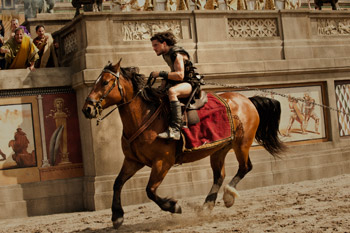 Kit Harrington calls his leading lady 'a wonderful balance of consummate professional and a pleasure to work with every day." He goes on: 'She's great fun on set and that's an essential dynamic, especially in a production this grueling. I've genuinely made a new friend."
Kit Harrington calls his leading lady 'a wonderful balance of consummate professional and a pleasure to work with every day." He goes on: 'She's great fun on set and that's an essential dynamic, especially in a production this grueling. I've genuinely made a new friend."
Insurmountable issues of class are not the only things standing between the young lovers. Quintus Attius Corvus, an arrogant and ruthless Roman Senator, has set his sights on Cassia and hopes to make her his wife. He was also the commander of the Roman soldiers who slaughtered Milo's family.
To play Corvus, the filmmakers turned to Golden Globe® and Emmy Award®
winner Kiefer Sutherland, well-known to audiences for his portrayal of Jack Bauer in the long-running hit series '24."
'I thought it would be interesting to take a familiar actor, known for playing a hero, and flip that by having him play the bad guy," says Jeremy Bolt. 'Kiefer Sutherland has the confidence to be a really delicious villain, and also be believable."
Paul W.S. Anderson asked the actor to channel the dark and twisted energy he had seen in earlier work, like The Lost Boys and Stand By Me. 'To me, it's almost like there are two Kiefer Sutherlands," says the director. 'There's Jack Bauer, who is a dark character, but ultimately a good guy. But it was the earlier Kiefer Sutherland I really wanted to reengage with and he was very much up for that."
Adds producer Don Carmody: 'His work as Corvus is a real revelation. I've never
seen him play a role like this before and he really nails it. He's a very scary villain."
For his part, Keith Sutherland says he signed on because of the quality of the screenplay and the people he would be working with. 'For me, it begins with the script," he says. 'I was so impressed with the writing of this. The dialogue was extraordinary. Plus, it's a really beautiful love story and I'm a sucker for that."
It was also an opportunity to work with a director he has long admired. 'One of the things I've always found most attractive about acting is that it is a collaborative effort, a team sport, if you will. And Paul W.S. Anderson has assembled one of the best teams I've seen."
Visually, the movie is breathtaking, according to the actor, and the story has
something for every kind of audience member. 'Some people will root for the love story," he says. 'Others will love the action"the fight sequences in the arena are extraordinary. For people who like history, the attention to detail is unmatched, and it's a beautiful, well-told story."
Jared Harris and Carrie-Anne Moss play Cassia's parents, Marcus Cassius Severus
and his wife Aurelia, a wealthy and ambitious power couple at the forefront of Pompeian society. Jared Harris, a classically-trained stage actor best known to American audiences as Layne Pryce in 'Mad Men" and Professor Moriarty in Sherlock Holmes: A Game of Shadows, says he was drawn to the project mainly because of its historical bent.
'I think everyone has heard of Pompeii," says Jared Harris. 'The complete annihilation of
the city and the idea that it happened so quickly is so fascinating in a macabre way. And I've always wanted to be in one of these gladiator films. I love this period of history. I begged Paul W.S. Anderson to throw me into the arena"I know how to sword fight. But he didn't go for it."
The wealthiest man in Pompeii, Marcus Cassius Severus has a grand vision to
reinvigorate the city, but he has drained his own resources and needs the Emperor's support for his projects. He hasn't counted on making his daughter a part of the agreement, however.
'He's a business man," says Jared Harris. 'He's a hustler just trying to get that deal done.
Pompeii suffered an earthquake about 18 years earlier and a lot of the city was destroyed. There's great opportunity for people to be involved in the rebuilding process."
But Corvus, who has come as the Emperor's representative, sees the situation as an
opportunity to enrich himself and ensnare the woman he covets. 'Severus is a good man with good intentions," Jared Harris believes. 'But he ignores all the danger signs in pursuit of that one goal. He ends up doing business with the equivalent of a gangster, a guy who doesn't bat an eye at having people killed."
Both Severus' wife Aurelia and daughter Cassia are independent women who speak
their minds. Aurelia also takes an active role in the Severus' development plans. 'It was very common for Roman women to be educated," says Paul W.S. Anderson. 'Severus is an intelligent man, but it really felt like the steely heart of that relationship, both the marriage and the business side of it, is Aurelia."
The opportunity to play such a strong female character was extremely appealing to Moss. 'Pompeii was a very modern culture and upper-class women wielded a degree of influence in society," she says. 'Aurelia is definitely the empress of this place. She embodies grace and strength, as well as humility. She and her husband have a strong marriage. They're very much equals.
'The script is a great combination of story, character, action and history," adds the actress. 'At this stage of my life I love to learn. During my research, I found so many things that surprised me. To think that this actually happened is pretty awe inspiring."
Milo's fiercest opponent in the ring becomes his strongest ally outside of it, as the captive Celt befriends Atticus, an African gladiator on the verge of winning his freedom. Atticus and Milo find real friendship as well as mutual respect, knowing that it is inevitable that they will eventually face each other in a fight to the death.
Atticus is played by Adewale Akinnuoye-Agbaje, the mysterious Mr. Eko of the
television series 'Lost." 'Ade brought a wonderful weight and gravitas to the role," says Paul W.S. Anderson. 'Because he's a fresh face to many moviegoers, he's able to inhabit that role totally without any baggage."
After many years as a slave, Atticus is one last victory from freedom, according to Roman custom. 'He trusts and believes in Roman law," says Paul W.S. Anderson. 'These gladiators have a code of honor by which they live. It's brutal, so for them life and death are sacred."
'A character this rich and heroic doesn't come around that often," says Adewale Akinnuoye-Agbaje of his role. 'Rarely in action films like this do you have such substantive drama and fully realised characters. The script doesn't shy away from the fact that these two men are bound to kill each other, but they are able find a kind of friendship and respect for each other. Atticus has one more kill before he's a free man, and that's what he's been living for. He cares about Milo, but he's not going to lose. Milo's death means Atticus' freedom."
Pompeii Wasn't Built In A Day
Before they began principal photography at Toronto's Cinespace Studio, the filmmakers began by constructing an astonishing glimpse of Pompeii in 79 A.D. through fastidiously researched production design, wardrobe and visual effects. Anderson worked closely with director of photography Glen MacPherson, production designer Paul Denham Austerberry, costume designer Wendy Partridge and visual effects supervisor Dennis Berardi to create the overall look of the film.
'This is the fourth time I've worked with Paul," says Austerberry, who led the
design team. 'The last period movie we did together, The Three Musketeers, we exercised a lot more creative license and made it much more stylised. With Pompeii, our goal was to make it big and epic, but keep it grounded in a gritty reality."
Producer Jeremy Bolt explains that CG effects were kept to a minimum to ensure
that quality. 'Unless you have some reality in every scene, you can't sell the reality of the film. The more you shoot in camera, the more likely the audience will believe it. The style of this film is very realistic. It's not science fiction; it's not a comic book or a graphic novel. It really happened. We agreed there would be no gimmicks or fancy camera work that would take you out of the film."
Austerberry was already familiar with the landscape of the city. He drew further
inspiration for the design and details of the sets from the wealth of source material compiled over the years by archeologists and historians. 'Much of the city still exists just as it was 2,000 years ago," he says. 'There are museums filled with artifacts and tons of documentation that we were able to utilise for our sets."
As an example, Austerberry points to the ancient amphitheater. 'We based the
murals on 19th-century paintings done during the excavation. Soon after they were unearthed, the originals were destroyed by frost. They crumbled right off the walls. The graffiti on the walls of the Pompeii market street set was based on drawings of actual graffiti"mostly political in nature"that was discovered and documented during the excavation. Because they were so meticulous about their documentation, and because so many of the ruins and artifacts still exist, we were able to be quite accurate about recreating the period."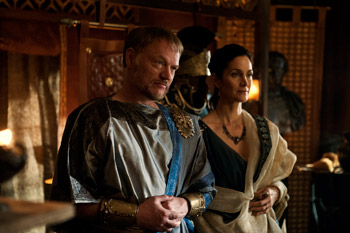 Austerberry and his team built close to 30 sets for the film, including Severus' opulent villa, the Pompeii streets, the amphitheater and the forum where some of the film's most vicious battles play out. For Severus' home, he referenced the architectural layout and details of two existing Pompeian villas.
Austerberry and his team built close to 30 sets for the film, including Severus' opulent villa, the Pompeii streets, the amphitheater and the forum where some of the film's most vicious battles play out. For Severus' home, he referenced the architectural layout and details of two existing Pompeian villas.
'The villa was an opportunity to showcase the sophistication and opulence of Roman civilization," says Paul W.S. Anderson. 'They had under-floor heating, a separate drinking water supply for all of their houses, even second-story plumbing. All of that was lost for about 1,700 or 1,800 years after the fall of the Roman Empire. So this is really a chance for us to show the beauty of Pompeii before we show the destruction."
One of the largest and most elaborate sets in the film, the Pompeii streets, took the
art department approximately 13 weeks to complete. Lined with stalls and stores selling everything from spices and bread to exotic birds and live animals, the street is a colorful recreation of what day-to-day life might have been like for the residents of Pompeii.
'The street set was based on one of the main shopping streets in Pompeii," explains
Austerberry. 'The cobblestones, each of which was hand-formed, were made to match the ones found in Pompeii. The market stalls were inspired by a bas-relief of the period that was sourced from a museum in Naples. And the tavola calda"which literally means -hot table'"is based on ones that were found intact in Pompeii and Herculaneum. In Roman times, the tavola caldas served as meeting places and were hubs of activity. Paul wanted authentic little vignettes of a bustling Pompeian market street."
Austerberry allows that certain liberties were taken with some of the sets, mostly for safety reasons. 'Some walls that appear to be made of stone and brick were actually constructed with foam, so that no one was injured during the fight sequences," says the designer. 'But overall, the architectural elements in the constructed sets match what you would have seen if you were walking through the real thing in 79 A.D."
Visual effects supervisor Dennis Berardi and his team at digital effects house Mr. X
were responsible for the film's magnificent scope, extending the practical sets to create the sprawling exteriors, as well as creating the dramatic effects of the cataclysmic eruption that unfurls in the third act.
Prior to principal photography, Paul W.S. Anderson and Berardi spent a week in Pompeii
filming the ruins, the mountain and the surrounding landscape to assist with the recreation of the magnificent ancient city. Over the course of a few days, they filmed over 35,000 high-resolution photographs from the ground and the air, often employing LiDAR, a sophisticated combination of laser and radar technology that measures distance with unmatched accuracy.
'We used the city itself to form the background of the digital effects," says producer
Jeremy Bolt. 'Just 15 years ago, it would have been much harder to make this film, but the advances in digital technology allowed us to recreate 79 A.D. Pompeii much more convincingly."
For Paul W.S. Anderson and director of photography Glen MacPherson, who have collaborated on four films together, shooting in 3-D has become the norm, but they agree that the format is particularly suited to Pompeii. 'It is a great tool to help tell a story," explains Glen MacPherson. 'It works so well for the battles and architecture of this period. The film has plenty of wide shots and spectacle and that's what 3-D is really designed for."
The biggest challenge with 3-D is keeping the production moving as a conventional shoot. 'There's a lot more gear involved, but Paul W.S. Anderson and I have developed our own system and our own shorthand," says Glen MacPherson. 'The images are fantastic and I don't think anybody on set realises we're shooting 3-D anymore."
Costume designer Wendy Partridge spent months doing extensive research for the
film's elaborate clothing. 'I immersed myself in what the early Romans wore and what Pompeii was like during that era," she says. 'One of the interesting things we discovered was that the style of clothing didn't vary much between economic classes, but the kinds of fabrics and especially the colors set people apart. Dyes were very expensive, particularly purple, so if someone had something purple, you knew they were wealthy."
Wendy Partridge and production designer Austerberry took the inspiration for the color
palette from Pompeii's rich frescoes. 'There was all this beautiful violet and gold, along with a lot of mint green. The backdrop for it all is an intense crimson accented with black. We decided that we would leave all the reds to Paul Austerberry, which meant that he used these beautiful rich hues in the sets and then the costumes settle beautifully in front of everything."
Wendy Partridge and her team of cutters and stitchers were responsible for making almost 3,000 complete costumes for the film. 'It was a huge undertaking," says the designer. 'Our workroom was flying for months and months making tunics and togas and armor. The jewelry for our principals was custom made. We had a full department making nothing but leather armor. We wanted to do everything possible to make the wardrobe historically correct, but also to make the actors look amazing, particularly when you're fitting guys who have worked so incredibly hard on their physiques."
Some of the most memorable scenes in Pompeii are set in the brutal and bloody world of the gladiators. Four weeks before principal photography started, the actors began training so that they would not only look like hardened professional athletes, but would also be able to endure fighting on camera for 12 hours a day. Physical trainer Nuno de Salles was recruited to whip the cast into shape.
'Each of the actors had different goals," explains Nuno de Salles. 'Kit Harington needed to build muscle, so his training was very weight-intensive, old-school bodybuilding. He did no cardio, because as he is a very lean guy already. Adewale needed to lose a little body fat, so his regimen included a combination of cardio and weights. Everybody followed a very strict diet. They were very dedicated and the results definitely show."
The point was not simply to look fit, however. They had to actually be fit. 'It was grueling work," says Akinnuoye-Agbaje. 'I would do an hour of cardio, followed by two hours of stunt training, then break for lunch, then an hour of weights with the trainer. We'd break for a half-hour review, then do another hour of cardio. But once I got onto the set and we got into the fight sequences, it all paid off. You really need this kind of physical tuning to make it look real."
'Our cast completely embraced the training," says Jeremy Bolt. 'Paul W.S. Anderson and I are quite experienced with putting our actors in the gym and getting them on the right diet, but not all of them go for it in the way that these guys have."
Renowned stunt and fight coordinator Jean Frenette, who choreographed the epic
confrontations in 300 and Immortals, created the intricate chorography for the vicious hand- to-hand combat of the arena. Harington and Akinnuoye-Agbaje, along with fellow actors Currie Graham and Sasha Roiz, and a group of highly trained stuntmen, spent weeks working through the film's complicated battle and fight sequences.
'Fighting is a physical language," says Jean Frenette. 'Each individual fight tells a story through the choreography and the body language. It's not just about kicking, punching, slashing and hitting. We bring character and narrative into the fighting."
The amount of close swordplay in the film necessitated long hours of rehearsals in
order for everyone to master the exact movements and placements.
'We went through a boot camp with the stunt guys," says Kit Harington. 'I had some experience working with swords in roles I've played in the past, but this is a different type of sword training: it's sword and shield, short sword rather than long sword. We spent about four weeks reviewing the basics of sword fighting, learning the fights and the movements. I really wanted to it look like I knew what I was doing with the sword."
Frenette has high praise for Harington's fighting skills. 'Kit Harington picked up everything so fast. He's very physical and very much into the action, which for me as a stunt coordinator is a real gift. He wanted to do everything."
Adding to the extreme physical demands of the film were the simulated smoke, dust,
fire and debris of the volcanic eruption. 'We tried to keep everything as realistic as possible, so we limited the CG wherever we could," says Paul W.S. Anderson. 'During the intense action sequences, like the climactic fight between Kit Harington and Kiefer Sutherland 's characters, the actors ended up sucking in a lot of ash, smoke and dust, making it very tough work for them."
'The environmental elements were challenging for everybody," says Keither Sutherland.
'Cast and crew had to work through them. But the ash was the worst. If you were doing dialogue, you ended up inhaling a lot of it, so we couldn't do takes for long periods of time."
'We've been pretty much covered in every element there is in this movie," says
Kit Harington. 'I've had mud, rainstorms and severe winds thrown at me. There were days when we were fighting outside in the amphitheater where the temperatures hit 100 degrees. But nothing beat the ash. It was pretty brutal."
Director Paul Anderson describes Pompeii as the most challenging picture he's ever made. 'Because of the sheer logistics of it, the enormity and the unpleasantness of the elements"the smoke, dust and debris"we were working in. We made a movie that feels like it's set at the end of the world, because that's what it was like for the people of Pompeii. Audiences will get an amazing glimpse into a world long gone, a time capsule of sorts, and a front-row seat to what was probably the greatest disaster of the ancient world."
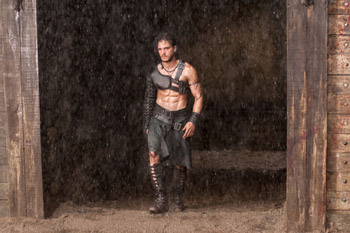 Pompeii Facts
Pompeii Facts
1) As depicted in Paul Anderson's POMPEII, on August 24 79 AD, Mount Vesuvius erupted, spewing a column of ash and pumice high into the atmosphere around the volcano at the rate of 1.5 million tons per second. The column rose 21 miles high, and was carried toward the cities of Pompeii and Herculaneum by strong easterly winds. Within hours, the cities were buried in ash and the volcanic cloud blocked out the sun completely, leaving the area in complete darkness. For terrified inhabitants it was about to get worse as a series of six devastating pyroclastic surges wreaked devastation beyond comprehension obliterating and burying Pompeii and Herculaneum.
2) The deadly pyroclastic surges that struck Pompeii are known as 'glowing avalanches" of hot ash wiping out everything in its path and laying waste to the city before the population had time to flee.
3) Recent excavations have found hundreds of bodies preserved in the volcanic material, with fear and desperation twisted on their faces for eternity. Nobody knows the exact number of people killed by the eruption of Vesuvius, but is believed to be in the thousands.
4) As studied and measured by geophysicists, and as depicted in Paul Anderson's POMPEII, the energy emitted by the explosion in 79 AD from Mt. Vesuvius was 100,000 times the thermal energy released by the Hiroshima bombing. Most of Pompeii's victims died instantly and were flash-heated to death. Any survivors would have been burned and asphyxiated to death.
5) As depicted in Paul Anderon's POMPEII, the eruption of Mt. Vesuvius in 79 AD was so powerful that the top of Vesuvius fell by 2000 feet with the effects compared to a nuclear blast! The eruption so intense that it filled in new shoreline moving Pompeii more inland.
6) Pyroclastic flows, such as those experienced from Mt. Vesuvius by Pompeian's in 79 AD, can move as fast as 450 mph with temperatures as high as 1,830 degrees F, exterminating everything in its path and making it impossible to escape.
7) Often overlooked by educators, historians and media, the 79 AD eruption of Mt. Vesuvius created a tsunami in the Bay of Naples.
8) As depicted in Paul Anderson's POMPEII, Mt. Vesuvius is a stratovolcano. Most rocks that erupt from Vesuvius are andesite, which creates explosive eruptions making Vesuvius especially dangerous and unpredictable, even today.
9) There is only one type of volcano more threatening to humanity than Mt. Vesuvius, it is the super-volcano. A super-volcano that erupted 250 million years ago is now believed to have created the greatest mass extinction the world has ever seen, wiping out up to 95 percent of all plant and animal species. Some scientists believe it was a volcano, not an asteroid, that killed off the dinosaurs 65 million years ago.
10) Could the United States become the next Pompeii? The second most cataclysmic event for Earth outside a asteroid strike would be a super-volcanic eruption. Super-volcanoes are hundreds of times more powerful than conventional volcanoes " with the potential to wipe out civilization as we know it. One of the world's largest super-volcanoes sits beneath Yellowstone National Park in the United States. An analysis of the molten rock within the dormant super-volcano has revealed that a super eruption is possible without any external trigger or warning, scientists say. If such an eruption should happen at Yellowstone, two- thirds of the U.S would become uninhabitable as toxic air sweeps through it, grounding thousands of flights, choking communication networks and forcing millions to leave their homes. The Yellowstone super-volcano has been rising at a record rate since 2004, which is of some concern to scientists.
11) Today, geologists and volcanologists who study Mt. Vesuvius concede that the volcano is overdue for an explosion. The Vesuvius Observatory monitors seismic activity, gas emissions and other indicators 24 hours a day to know at the earliest point when it may erupt. It would be more deadly today as the Bay of Naples has a current population of 3 million people.
12) As depicted in Paul Anderson's POMPEII, the slaves who fought as gladiators were from a diverse set of cultures and races. This is an accurate portrayal of slavery under Roman law, which had nothing to do with one's race, only with which country or rebellion the Romans had subdued. Slaves came from Britannia to Africa, and from all over the Empire. Even in hard economic times, it would not be uncommon for desperate Roman citizens to raise money by selling their own children into slavery.
13) Prior to production of Pompeii, the filmmakers Paul Anderson, Jeremy Bolt and team, spent six years researching Pompeii. They imaged every street and building in the city and the surrounding area so that the film would portray this magnificent civilization as accurately as possible. The team conducted extensive flyovers of Mt. Vesuvius, as well as active volcanoes, so that the imagery in the film would be as visually accurate as possible.
14) The lifestyle of the wealthy Pompeian's was one of opulence and unparalleled luxury, even by today's standards. Their diet consisted of a wealth of fish, nuts, grains, olives, fruits, and according to recent excavations, may have included giraffe and flamingoes as Pompeian restaurants had a long-distance business of trade in exotic and wild animals.
15) Mt. Vesuvius is a super power of the natural world, today it stands as threatening as ever. The next eruption would be devastating and the next eruption is expected to be an enormous cataclysmic explosion and possibly worse than that of 79 AD. It could change the climate of all of Europe and might make it impossible to evacuate the 3 million residents currently living in close proximity to it at the Bay of Naples.
Pompeii
Release Date: February 20th, 2014
MORE





